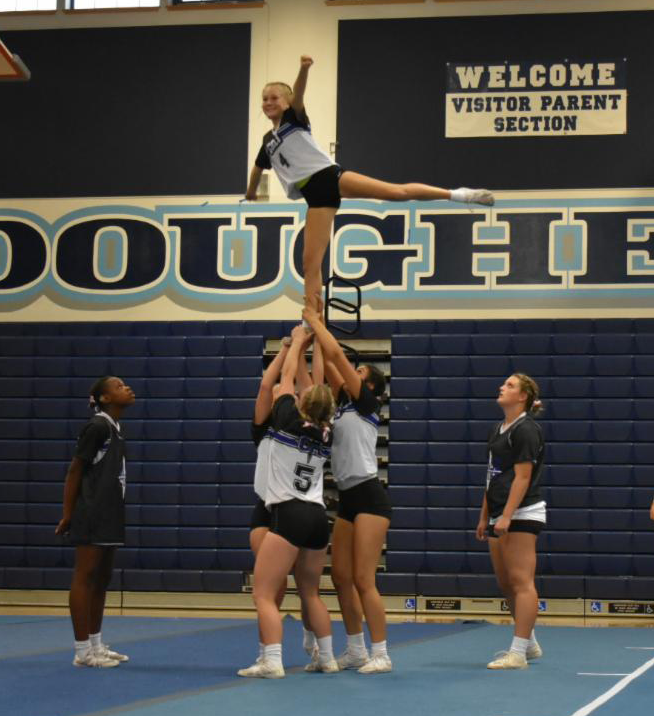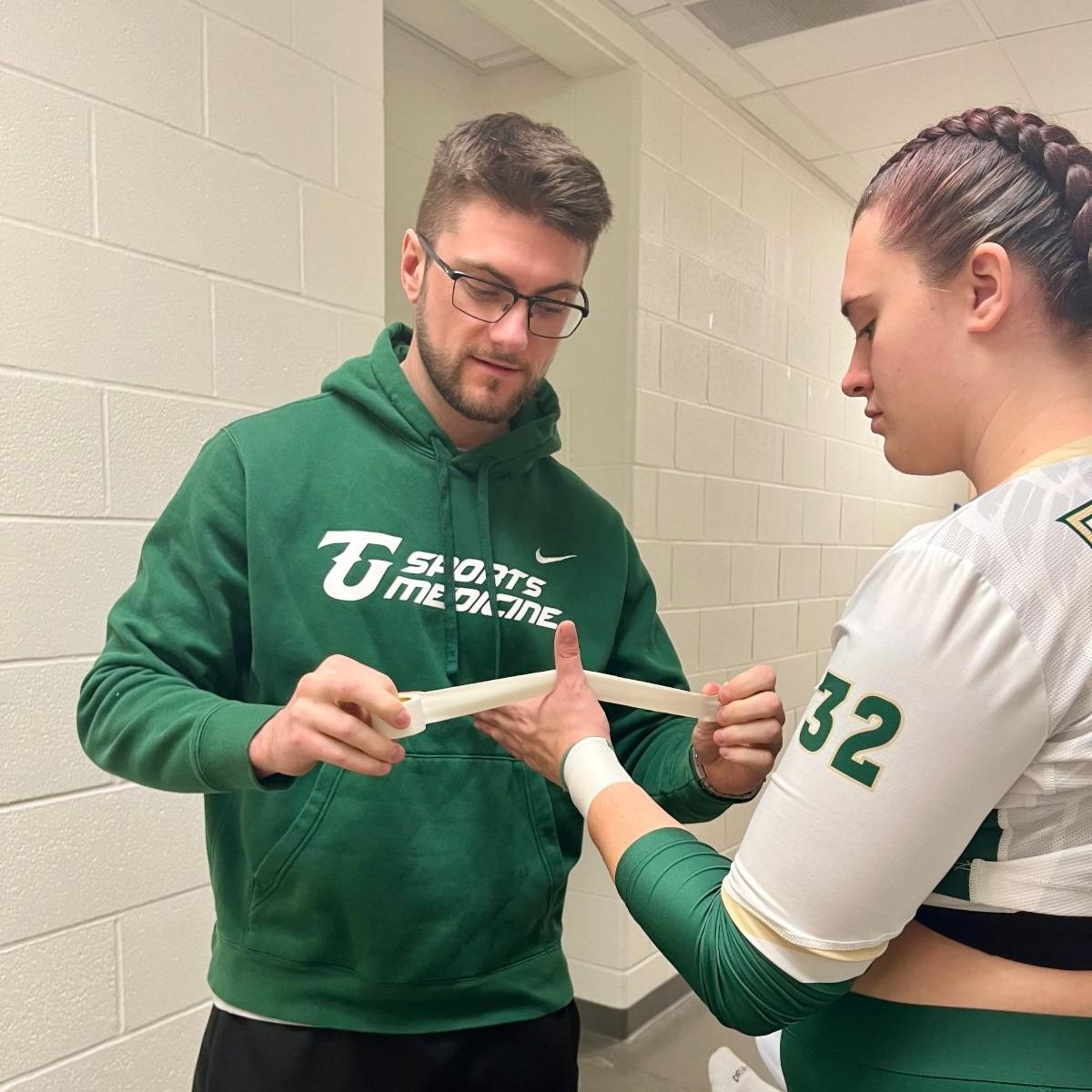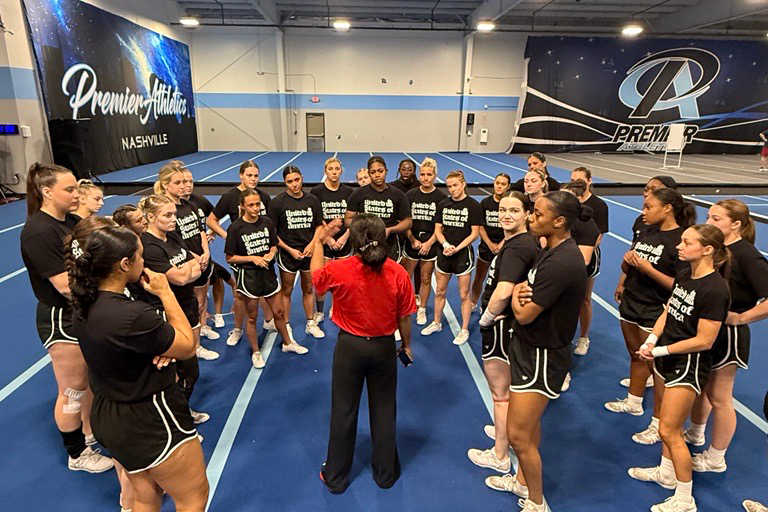National Cheer Safety Month 2025 is Here!!
Get ready to learn, engage, share, and continue making cheer and STUNT safety a priority throughout next month.
National Cheer Safety Month is a dedicated time for the cheerleading community to focus on promoting safety practices, increasing awareness about injury prevention, and fostering a safer environment for all participants. The 2025 theme is “Cheer for Safety.” We want to be vocal about the improvements the cheer community has made in reducing serious injuries and in keeping cheer as one of the sports with the lowest injury rates. We want you to engage with us to tell the world what steps you’re taking to keep cheerleading safe. Each week, we will share information on what is being done and where we can improve safety in regard to injury prevention, concussion prevention, athlete protection, athlete wellness, and other important safety topics.
Through education, awareness, and a commitment to safety, National Cheer Safety Month aims to minimize risks and ensure that cheerleading remains a fun, healthy, and secure activity for all. By doing our part, we can collectively keep cheerleading and STUNT safe.
Follow our socials and join us back here each week of National Cheer Safety Month for more information on how to Cheer for Safety!
Today! Let’s kick off NCSM by updating your social media profile pics and taking the iCheerSafe Pledge with your team!

Safety Month Special!
Starting Aug 1 – Take an additional $5 off of the USA Cheer Cheerleading Safety Manual or the Safety Manual/High School Rules Book Combo!
Access to injury data is vital to helping keep cheerleading safe. As cheerleading has been included in sports injury surveillance systems, we’ve used this data to help monitor cheerleading safety, see the effectiveness of rules changes and education, and make determinations on what steps can be taken to address safety concerns.
USA Cheer has updated the most recent cheer injury data, and once again, most markers point to a great safety record for cheer over the past decade and more.
View all of the updated stats on our Cheerleading Safety Data and Research Page!
Overall injury rates for cheerleading are the 17th lowest out of 20 high school boys’ and girls’ sports
Catastrophic injuries in cheerleading have dropped by over 85% in the last 10 years, from 42 cases to only 6.

Emergency room visits: Total visits remain lower than several other girls’ sports.

Concussion Concerns:

These figures above are cause for celebration, as they demonstrate that the measures taken in recent years have had a positive impact on those who participate.
However, the data also shows that within those numbers, there is an uptick in concussion rates that must be addressed. Cheer has consistently been in the middle of the 20 sports studied by the High School RIO (Reporting Injury Online) surveillance system. In the latest report for the 2023-24 school year, cheerleading concussion rates were up.
With a focus on skill progression, proper spotting, appropriate use of mats, and attention to practice fatigue, we can improve concussion rates and return them to their previous lower levels. Review our concussion resources here:
What can you do with this information?
- Let people know that when done properly, cheer is a safe sport/activity!
- Focus on your program to help make these numbers even better: Follow the rules, take time during skill progressions, speak up if you’re scared to try a new skill, use proper matting and spotting.
- Follow proper protocols when returning from injury, especially from a concussion. Brain injuries that don’t heal can become life-changing if a second impact is sustained.
- Get your athletic trainer involved in monitoring and reporting to your school, state, and the national surveillance system to help us continue to get injury data for safety improvements!
Stay tuned next week as we focus on how to prevent injuries!
Injury prevention is the focus of cheerleading safety. There are several important steps all stakeholders can take to minimize the risk of an injury occurring in your cheer program. Together we can help keep the gains we’ve made in overall cheerleading safety and address current concerns regarding an increase in concussion rates.
Follow the Rules for Your Level
Rules are in place to restrict certain types of skills that may create an undue risk of injury, especially an injury to the head, neck, and back of the athlete. Each level has different rules that address the unique characteristics of that level. Be sure to stay within your rule level to minimize risk of an injury.
Click here for the 2025-26 NFHS/USA Cheer High School Rules Changes

Use Skill Progressions and Stay Within Your Ability Level
An important piece of keeping yourself safe is knowing your limitations. Just because you’ve seen another team perform something doesn’t mean it’s safe for you. Don’t just throw something because you’re on a mat or because you have extra spotters. There’s a better way to try that skill. Start by being honest about your current abilities and then make a plan to achieve your goal safely.
Follow proper skill progressions when learning new skills. This means starting with the fundamentals and perfecting them before moving to the next difficulty level. For example, your elevator prep should be solid before ever extending. Your double based extension should be solid before ever trying a liberty. If you find that stunts are shaky or falling, you may need to take a step back and work on the leadup skills some more! It might feel like you’re advancing more slowly, but setting up a good foundation will pay off in the long run!
Resources for skill progressions

Use Spotters and Matting Effectively
Even when following the rules and using skill progressions, falls can and do occur, especially when learning new skills. While they should never be put in place of skill progressions, using spotters and mats can be an effective tool in preventing a fall from becoming an injury, especially a serious one. Spotters should be actively trained in progression just like skills, demonstrating proficiency at spotting lower-level skills before moving to more advanced skills.
Require and Maintain Coaches’ Education
Even when following the rules and using skill progressions, falls can and do occur, especially when learning new skills. While they should never be put in place of skill progressions, using spotters and mats can be an effective tool in preventing a fall from becoming an injury, especially a serious one. Spotters should be actively trained in progression just like skills, demonstrating proficiency at spotting lower-level skills before moving to more advanced skills.

Provide Access to Athletic Trainers
Athletic trainers play a crucial role in preventing and minimizing sports injuries. They can help design and implement injury prevention programs, educate athletes on proper techniques, and provide immediate care for injuries when they occur. They are a key component of an emergency action plan and can also work with athletes on rehabilitation and overall health and wellness. Athletic trainers also help track injuries and provide data to national injury surveillance programs that help monitor changes in safety rules and training. Don’t wait until National Athletic Training Month in March to thank your AT!
Following Protocols for Emergency Plans and Return to Play
 Injury prevention is the goal, but in case an injury does happen, response and return protocols should be in place and followed to help prevent further injury.
Injury prevention is the goal, but in case an injury does happen, response and return protocols should be in place and followed to help prevent further injury.
Do you have your emergency action plan ready for this season? Review Emergency Action Plans here.
Do you know your concussion return protocols? Review our concussion resources here.
Stay tuned next week as we expand safety beyond just injury prevention!
This week we go beyond just preventing injuries. Cheerleading safety also means addressing mental health and being safe from bullying, abuse, and misconduct. This week, we focus on our partnerships that help provide training to coaches, athletes, and parents to help address these important issues.
Body Positivity and Confidence
 Creating a body-positive environment is a crucial component in our collective mission of ensuring athletes reap the many rewards that sports have to offer. Read about how you can help create a culture where athletes feel safe, supported, and focused on what their bodies can do—not how they look.
Creating a body-positive environment is a crucial component in our collective mission of ensuring athletes reap the many rewards that sports have to offer. Read about how you can help create a culture where athletes feel safe, supported, and focused on what their bodies can do—not how they look.
Uniform traditions in cheerleading have evolved over the years, and emerging research and athlete feedback point to the need for a more modern, inclusive, and athlete-centered approach. After many months of reviewing current guidelines and
recommendations with respected industry leaders and athletes, USA Cheer has developed the following position statement:
Prioritizing Athlete Wellness: USA Cheer Urges Thoughtful, Body-Positive Uniform Guidelines
Photographers play a critical role in how cheerleading is portrayed to the public. USA Cheer has developed guidelines that are intended to ensure all photo and video content reflects the athleticism, teamwork, and spirit of cheerleading, while protecting athlete dignity and safety—especially that of minors. Read more below and share with your photographers.
USA Cheer Photographer Guidelines
 USA Cheer is proud to support the Body Confident Sport program to help girls build body confidence and make sports a place where girls feel like they belong. This program was developed by Dove and Nike, in partnership with world-renowned researchers and experts – the Tucker Center for Research on Girls & Women in Sport and the Centre for Appearance Research. Together we can help build body confidence and make sport a place where all girls feel like they belong.
USA Cheer is proud to support the Body Confident Sport program to help girls build body confidence and make sports a place where girls feel like they belong. This program was developed by Dove and Nike, in partnership with world-renowned researchers and experts – the Tucker Center for Research on Girls & Women in Sport and the Centre for Appearance Research. Together we can help build body confidence and make sport a place where all girls feel like they belong.
Body Confident Sport provides coaches with the materials they need to increase girls’ body confidence, body image and self-esteem through sport. Download the tools today to help girls build body confidence and make sports a place where they feel like they belong.
Watch our special webinar with Body Confident Sport below and take the free coaches’ training!
Read more about USA Cheer’s Body Positivity Initiatives
Hazing and Bullying Prevention
 All spaces should be safe spaces free from bullying and hazing, and cheer is no different. These actions are the opposite of what makes a team great. Strong team bonding and inclusiveness will set the foundation for achieving your goals faster. Coaches and administrators should make it clear that there is a zero-tolerance policy for bullying and hazing, and veteran athletes should show leadership by ending any “traditions” that demean or harm parts of your team. Taking it a step further, cheerleaders should be the “upstanders” in their schools, setting an example and helping to create a school spirit environment where everyone is welcome.
All spaces should be safe spaces free from bullying and hazing, and cheer is no different. These actions are the opposite of what makes a team great. Strong team bonding and inclusiveness will set the foundation for achieving your goals faster. Coaches and administrators should make it clear that there is a zero-tolerance policy for bullying and hazing, and veteran athletes should show leadership by ending any “traditions” that demean or harm parts of your team. Taking it a step further, cheerleaders should be the “upstanders” in their schools, setting an example and helping to create a school spirit environment where everyone is welcome.
Read more about Bullying Prevention and be sure to join us in October
Preventing, Recognizing, and Reporting Abuse and Misconduct
 It is vital that all stakeholders are aware of how to prevent, recognize, and report abuse and misconduct. The USA Cheer Athlete Protection Courses for coaches, athletes, and parents help inform everyone of policies that take away opportunities for abuse to awareness of red flags to steps for reporting. All USA Cheer members are required to complete this training and are subject to the USA Cheer Code of Conduct and Minor Athlete Abuse Prevention Policies.
It is vital that all stakeholders are aware of how to prevent, recognize, and report abuse and misconduct. The USA Cheer Athlete Protection Courses for coaches, athletes, and parents help inform everyone of policies that take away opportunities for abuse to awareness of red flags to steps for reporting. All USA Cheer members are required to complete this training and are subject to the USA Cheer Code of Conduct and Minor Athlete Abuse Prevention Policies.
As we wrap up National Cheer Safety Month ‘ 25 this week and head into the school year, let’s all take time to reflect and refocus our efforts for safety. This week we’re going to be sharing safety tips from the experts, including yourself! Then be sure to finish off the month by taking the safety quiz to earn and share your badge. Let’s make 2025-26 the best and safest season yet!
Take the Quiz and Earn Your Badge
Safety Tips from the Pros!
Check back all week as we update our tips from our experts, coaches, and athletes!
Progression of skills is the framework for keeping athletes safe. Master each step before moving on.
– Melissa McPherson, STUNT Official, Choreographer, and Coach Former Cheer Coach
Know when to stop pushing or practicing. Exhausted athletes make mistakes & lose technique.
– Sandi Gildehaus, Head Coach St. Francis Borgia, President MCCA (MO)
A proper warm-up is as important as proper hydration and proper meal intake.
– Dr. Ryan “Pete” Manely, Director of Athletic Training Services, Sterling College
Spotting technique at the beginning of the season. Don’t skip a quick spotting seminar.
– Jason Anderson, Freshman Coach, Lowery Freshman Center
Teaching the top how to fall properly will reduce the risk of injuries to them and their bases.
– Jessica McDermott, Head Coach, Barnegat HS & Coach, World Cup Allstars
Just because you saw another team do it on social media, doesn’t mean it’s safe/legal to replicate.
– Jenna Wilkins, Head Coach, Marcus HS
Use your resources: athletic trainers, strength coach, dietitian, sports psychologist, and more!
– Anda Udris, USA Cheer National Team Athletic Trainer
If your flyer is falling, LET GO OF THE FEET and catch your flyer’s body!!!! Feet up=head down=bad
– Sarah Otto, Head Coach, Union HS
Be sure stunting area is clear. Move anything that even MIGHT get in the way. Athletes must be trained to look.
– Joella Nall, Head Cheer Coach, Elizabethtown HS
Listen to your body.
Karen Lew Feirman – DHSc, LAT, ATC, USA Cheer Safety Council
If you don’t feel comfortable doing the skill, it’s ok to say that.
Dr. Ryan “Pete” Manely, Director of Athletic Training Services, Sterling College
Do you have a tip to add? Send it to us here!






